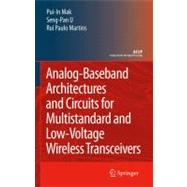
What is included with this book?
| Introduction | p. 1 |
| Transceiver Architecture Selection - Review, State-of-the-Art Survey and Case Study | p. 9 |
| Two-Step Channel Selection - A Technique for Multistandard Transceiver Front-Ends | p. 41 |
| System Design of a SiP Receiver for IEEE 802.11a/b/g WLAN | p. 71 |
| Low-Voltage Analog-Baseband Techniques | p. 89 |
| An Experimental 1-V SiP Receiver Analog-Baseband IC for IEEE 802.11a/b/g WLAN | p. 143 |
| Conclusions | p. 171 |
| Table of Contents provided by Blackwell. All Rights Reserved. |
The New copy of this book will include any supplemental materials advertised. Please check the title of the book to determine if it should include any access cards, study guides, lab manuals, CDs, etc.
The Used, Rental and eBook copies of this book are not guaranteed to include any supplemental materials. Typically, only the book itself is included. This is true even if the title states it includes any access cards, study guides, lab manuals, CDs, etc.